The Neo Geo ネオジオ (also stylized as NEO•GEO or hyphenated as Neo-Geo) is a cartridge-based arcade and home video game system released in 1990 by SNK. The system offered comparatively colorful 2D graphics and high-quality sound, along with a memory card storage system usable on both versions of the system. A major platform for arcade games at the time, the system was also available as a high-end home gaming console. The two versions of the system were known as the AES (Advanced Entertainment System, the home version) and the MVS (Multi Video System, the arcade version). The Neo Geo was marketed as 24-bit, which may be a reference to either its 24-bit graphics data bus or its 8/16/32-bit multi-processing system.
History[]
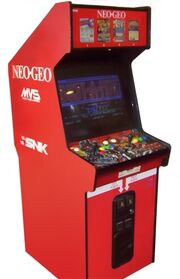
Neo Geo 4-slot MVS arcade cabinet
The Neo Geo hardware was an evolution of an older SNK/Alpha Denshi M68000 arcade system board that was used in Time Soldiers in 1987, further developed in the SNK M68000 hardware platform as used for P.O.W. - Prisoners of War in 1988. Contrary to other popular arcade hardware of the time, the SNK/Alpha Denshi hardware used sprite strips instead of the more common tilemap based backgrounds.[13] The Neo Geo hardware was essentially developed by Alpha Denshi's Eiji Fukatsu, adding sprite scaling through the use of scaling tables stored in ROM as well as support for a much higher amount of data on cartridges and better sound hardware.
The Neo Geo was announced on January 31st, 1990 in Osaka, Japan and released on April 26th, 1990.
The home system was originally a rental unit, but SNK quickly began selling the system through stores when customer response indicated that people were willing to spend the money. Compared to the other consoles of the time, the Neo Geo had much better graphics and sound. This likely helped the system to survive the longest life of any fourth-generation video game console, outlasting the popular Super Famicom and Sega Mega Drive.
The home system featured two CPUs: a 16/32-bit Motorola 68000 main processor running at 12 MHz and an 8-bit ZiLOG Zilog Z80 coprocessor running at 4 MHz. A custom video chipset allowed the system to display 4,096 colors and 380 individual sprites onscreen simultaneously, while the onboard Yamaha 2610 sound chip gave the system 15 channels of sound with seven channels reserved specifically for digital sound effects. However, the screen resolution for the games were slightly lower then comparable games at the time, and the MVS cabinet used in the United States also had unusual video hardware which made the games visuals appear slightly more dark and contrasted then other games.
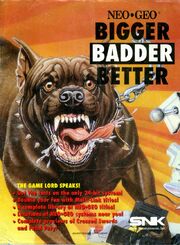
In the United States, the console was originally planned to debut at $599 USD and included two joystick controllers and a game (either Baseball Stars or NAM-1975). However, this plan was quickly scrapped and when the system had its American launch, it debuted at $649.99 USD with two joysticks, a memory card, and a single pack-in game, Magician Lord (the early Neo Geo boxes had a gold sticker announcing the inclusion of Magician Lord over the initially planned choice of two games). This package was known as the "Gold System." The system was also released in a "Silver System" package, which included one joystick controller and did not include a game or memory card. Other games cost $200 USD or more each. With these "premium" prices, though, most gamers weren't able to afford the system, so the console was only accessible to a niche market. NeoGeo AES was launched with the slogan "Bigger, Badder, Better" and a huge marketing campaign which included ads in many magazines and television commercials on target networks.
The Neo Geo was driven into cult status partially by changing mainstream tastes, which soon demanded flashy 3D graphics. Even after the console ceased production for the home market, the quality of Neo Geo games kept it alive in arcades, particularly in Japan, where the newest installment of its flagship franchise, The King of Fighters, caused a stir with every new release.
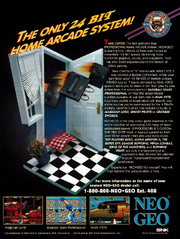
The last game by SNK for the Neo Geo system, Samurai Shodown V Special, was released on October 19, 2004. SNK decided to abandon the hardware due to the rampant piracy of games built for the system, which SNK believed was partially responsible for its bankruptcy in 2000. SNK ceased to manufacture home consoles by the end of 1997, but software for both home and arcade hardware was produced for many years after. Measured from the introduction of the arcade hardware in 1990 to the release of the last home cartridge in 2004, the Neo Geo's fourteen-year official span of support from its manufacturer makes it the second longest-lived arcade or home console system ever produced. Only the Atari 2600, which was supported from 1977 until 1992, had a longer lifespan.
A new cartridge-based game called Last Hope was released for the home console in 2006 by the independent NG:DEV.TEAM, running at 60 fps and showcasing the continued ability of the Neo Geo even sixteen years after its debut. The game features both hand-drawn and CG graphics with transparency and lighting effects as well as a techno soundtrack.
On August 31, 2007, SNK stopped offering maintenance and repairs to Neo Geo home consoles, handhelds, and games. However, they will continue to repair their arcade hardware.
Emulation[]
The GameTap subscription service currently includes a Neo Geo emulator and a small library of Neo Geo games.
In February 2007, Nintendo announced on their Japanese website that Neo Geo games would appear on the Wii's Virtual Console in Japan; announcements in April and July confirmed placement on the North American Virtual Console, and on October 1st, a similar announcement was made for the European Virtual Console. NeoGeo games were made available on the Australian and European Virtual Console on October 5th, and North American Virtual Console on October 8th.[6] The first three games released were Fatal Fury: King of Fighters, Art of Fighting, and World Heroes.
Neo Geo games released on the Virtual Console cost 900 Wii Points ($9 USD) in all regions.
Neo Geo games are also available through Xbox Live Arcade. As of February 2009, Fatal Fury Special, Samurai Shodown 2 and Metal Slug 3 have been added. Metal Slug 7 and King of Fighters '98 have been announced as future releases.
Technical aspects[]
Each joystick controller was 280mm (width) x 190mm (depth) x 95mm (height) (11 x 8 x 2.5 in.) and contained the same four-button layout as the arcade MVS cabinet.
The MVS (Multi Video System) is the arcade form of the Neo Geo, and the operator could install multiple games on one cabinet, depending on the type of motherboard used. There are several single-slot motherboard variations (all of which are capable of playing one game at a time), along with a two-slot motherboard for playing two games, one that could run up to four games, and lastly, one which held up to six games. The AES (Advanced Entertainment System) is the home version of the Neo Geo hardware. Early motherboard revisions of the AES console contained daughterboards used to enhance the clarity of the video output.
The programming code is the same on both the MVS and AES hardware. In fact, owners could move EPROMs from one type to the other, and the game would still run. The program specifics for both MVS and AES game options were contained on every game ROM, whether the cartridge was intended for home or arcade use. However, the arcade and home cartridges do have a different pinout. They were designed this way to prevent arcade operators from buying the cheaper home carts and then using them in arcades.
Memory Card []
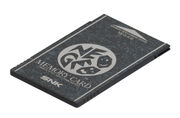
Neo Geo Memory Card
When it first came out, the Neo Geo was the first-ever video game system to use memory cards for saving the player's progress on any game. It is a 2KB memory card based on the 68-pin JEIDA ver. 3 computer memory card standard, and could store up to twenty-seven save files. Another innovative feature of this accessory is that it could be used on both the home and arcade systems, so essentially the player can play a game at the arcade, save his progress and continue where they left off at home on the same game. This process also worked the other way around. An early flyer for the Neo Geo hardware claimed that both the AES (referred to as the Neo Geo Rental System in said flyer) and the MVS are "networked" in this way by means of the memory card.
ROM sizes and startup screens[]
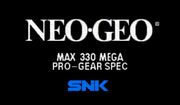
Specification for ROM size was up to 330 megabits, hence the system displaying "MAX 330 MEGA - PRO GEAR SPEC" upon startup. While no technical specifications were required to display it, some games over 100 megabits followed this screen by displaying an animation proclaiming "The 100 Mega Shock". The original ROM size spec was later enhanced on cartridges with bank switching memory technology, increasing the maximum cartridge size to around 716 Mbit. These new cartridges also caused the system to display "GIGA POWER" upon startup, indicating this enhancement.
Graphics[]
Unlike other video game consoles of its time, the Neo Geo did not use tilemap background layers. Instead, it relied exclusively on drawing sprites to create the background. Sprites are vertical strips which are 16 pixels wide, and can be 16 to 512 pixels tall. By laying multiple sprites side by side, the system can simulate a background layer. The system can draw up to 384 sprites on the screen at a time, and up to 96 per scanline.
Networking/Communications Services[]
Early advertising for the Neo Geo detailed a modem cartridge for the AES that would allow the user to access various services such as home banking, home shopping and others. Along with that, there is a feature of having a password stored on the memory card for security purposes. Such a feature would have made the AES more than just an advanced gaming console; it would have also made it usable as a terminal of correspondence. Ultimately, no such accessory was ever released for the AES.
Specifications[]
Processor[]
- Main Processor: Motorola 68000 running at 12 MHz
- Although the MC68000 CPU was designed by Motorola, there were many other clones of this CPU found in the Neo Geo hardware. The most common CPU is the TMP68HC000 manufactured by Toshiba.
- Co-Processor: Zilog Z80 running at 4 MHz. This is also used as an audio controller.
- Sound chip: Yamaha YM2610 15 Sound Channels. 7 Digital, 4 FM synthesis, 3 PSG, and 1 Noise Channel.
Memory[]
- Main Memory (used directly by 68K): 64KB
- Main Video memory: 74KB
- Video Memory: 64KB
- Palette Memory: 8KB
- Fast Video RAM: 2KB
- Sound Memory (used directly by Z80): 2KB
Display[]
- Display resolution: 320x224 (many games only used the centermost 304 pixels)
- Color Palette: 65,536
- Maximum Colors On-Screen: 4,096
- Maximum Sprites On-Screen: 380
- Minimum Sprite Size: 1x2
- Maximum Sprite Size: 16x512
- Maximum Sprites per scanline: 96
- Background Layers: 0
- Aspect ratio: 4:3
- A/V output: RF, composite video, RGB (with separate 21 pin SCART cable FCG-9).
Sound[]
- Sound CPU: Z80 at 4 MHz
- Sound hardware: YM2610 at 8 MHz, stereo sounds up to 56 kHz
- 4 channels FM (4 operators + LFO)
- 3 PSG
- 1 noise
- 7 4-bit ADPCM
- Work RAM (sound): 2KB
- Sound ROM 128KB on-board (only less than 32KB used)
- up to 512KB sound ROM on cartridges
Power[]
- Source: separate DC 5V (older systems) and DC 9V adapter (newer systems).
- Consumption: 8W older Systems, 5W newer Systems
Dimensions[]
- Console: 325 mm (width) x 237 mm (depth) x 60 mm (height).
- Controller: 280 mm (width) x 190 mm (depth) x 95 mm (height).
Storage[]
- Removable Memory Card: 2KB or 68-pin JEIDA ver.3 spec memory card
- Any 68-pin memory that fits the JEIDA ver.3 spec will work
Collecting[]
Home cartridges[]
There is a thriving collector's scene for the Neo Geo home systems, especially the original AES home console. This is mainly because of the limited runs received by cartridges, the massive arcade library available, and the system's reputation as a 2D powerhouse. It is still common even to this day for both Neo Geo consoles and cartridges to fetch extremely high prices on eBay and other auction websites, particularly English versions of cartridges as these were produced in fewer quantities. A handful of the rarest Neo Geo games can sell for well over $1,000 on eBay.[citation needed] This gives the system an almost cult following, as owners see the system as more of an "investment" rather than an ordinary videogame console. This leads to high resale value on most Neo Geo systems and games and makes the console a "must-have" for a number of video game collectors. The most expensive cartridge for the Neo Geo home system is the European-localized version of Kizuna Encounter: there are only four known copies of the game, with the most recently sold copy selling for $12,500 USD. This version of the game contains 2 unlockable and playable characters that have special abilities and weapons.
Arcade cartridges[]
Another sub-scene within the Neo Geo collector's market involves the MVS cartridges. Although these were initially designed for arcade use, a strong market has developed around collecting this particular format. The MVS market can be divided into two distinct groups: those who are looking for cheaper alternatives to the expensive rare home carts, and those who are interested in paying premium prices for complete arcade kits.
For those interested primarily in lower prices on rare home games, MVS carts, particularly loose carts or incomplete kits, can offer a cost effective alternative. Most MVS cartridges cost substantially less than their home counterparts. This lower price can be associated with their lack of decoration as most were designed to be installed inside arcade cabinets and lack cartridge artwork or box artwork, the high set-up cost of purchasing the MVS system, and the prevalence of bootleg cartridges. Many of the most common MVS games go for prices between $10-$150.
However, in recent years a growing market has emerged for complete MVS arcade kits. These consist of all the materials that would be initially sent to an arcade operator, including the brown cardboard shipping box (with label), the insert materials to decorate the marqee and arcade cabinet (including separate move lists), warning information, dipswitch settings, in some cases even posters and/or any packing materials. Because many of the items in an MVS kit were designed to be discarded by arcade operators, finding complete arcade kits can be difficult and thus the prices for some complete MVS kits can be quite high.
Because of the conflicting requirements and desires of the two MVS sub-groups, they rarely compete with each other for games.
Counterfeit or bootleg software is regarded in the collectors community as having zero value or very low value. Such software has a reputation for audio and video flaws, and is generally disparaged by fans of the Neo Geo systems. This software is identifiable by visual inspection of the game PCBs, or by comparison of ROM CRC values using a specially designed BIOS.
Graphical development[]
The Neo Geo was particularly notable for its ability to bring arcade-quality graphics directly into the home. As time went on, programmers were able to further tune the games to produce higher quality graphics than previous years and eventually beyond what was initially thought possible for the system.
One of the pack-in games with the original Japanese release was NAM-1975, a side-scrolling shooting game that featured multi-layer scrolling backgrounds. However, the initial Neo Geo games were, graphically speaking, a little less polished than SNK's non-Neo Geo games. By 1991, games like King of the Monsters demonstrated the Neo Geo's ability to produce graphic detail that matched or surpassed contemporary arcade games from the period.
In 1992, SNK's Art of Fighting marked the beginning of a series of 2-D fighting game innovations. This landmark game brought visual graphic damage to the characters' faces when hit, as well as large character sprites in combination with zoom effects to intensify the action. This zoom feature was also used in the following year's Samurai Shodown, whose even more elaborate graphics and gameplay won it Electronic Gaming Monthly's award as the 1993 Game of the Year and launched a successful franchise. The Neo Geo also became known for its shooters, with the first successful title coming with 1994's Aero Fighters 2. The following year's Pulstar managed to up the ante on both graphics and gameplay.
By the mid-1990s, SNK was trying to move onto a new platform, notably the Hyper Neo Geo 64. When the new 3-D system failed to take off, however, SNK found itself still developing games for its old 2-D engine. This led programmers to come up with ways to increase the limits of what was initially thought possible for the system.
Six years after the Neo Geo's initial launch, Nazca surprised the video game industry with Metal Slug. A take from the Contra series, Metal Slug is a run-and-gun game that featured cartoonish, hyper-active graphics and gameplay that had also launched a very successful franchise. Since the Neo Geo was unable to produce the 3-D games that began dominating arcades in the 1990s, SNK focused on mastering the realm of 2-D. With the launch of The Last Blade in 1997, SNK programmers demonstrated that the Neo Geo was still capable of producing artistically rendered graphics to match the gameplay.
While the system became primarily known for its fighting games in the late-1990s, notably The King of Fighters series, 1998's Blazing Star updated the previous Pulstar with more detail. This trend of adding more detail to 2-D environments reached a plateau with 1999's Garou: Mark of the Wolves, an update of the Fatal Fury series, as well as Metal Slug 3.
See also[]
Videos[]
References[]
External links[]
- Official 20th anniversary website, English page
- NEOGEO Station, Official Facebook page
- NEOGEO Wii Virtual Console
| This page uses Creative Commons Licensed content from Wikipedia (view authors). |

